
An AC-130U Spooky Gunship from the 4th Special Operations Squadron jettisons flares over an area near Hurlburt Field, Florida, on August 20, 2008. The flares are used as a countermeasure to heat-seeking missiles that can track aircraft during real-world missions. Photo by Senior Airman Julianne Showalter
During the Korean War, the United States Air Force recognized there was a need for a large multipurpose aircraft that could be modified to perform both combat and humanitarian missions in far-flung locales. Such a plane would need to be able to land on, and take off from, short runways, and also have enough cargo space to transport artillery pieces, tanks, and troops over long distances.
Lockheed was contracted to develop the prototype. In 1954, the company unveiled the C-130 Hercules, a four-engine turboprop that was capable of transporting up to 92 combat troops, plus their gear, and had a maximum cargo load of 42,000 pounds. Since then, more than 70 variants of the C-130 have taken to the skies to carry out a range of missions. One of the most prolific variants is the AC-130, a heavily armored ground-attack gunship that has participated in every major American conflict since the Vietnam War.
From weather reconnaissance to “commando hunts” to wildfire suppression, here are some of the more notable roles the versatile C-130 has undertaken over the decades to earn its reputation as one of the most significant military innovations of the modern era.
Related: ‘The Worst Flight Ever’: Inside An Unforgettable Mission Into Hurricane Ian
The ‘Hurricane Hunters’ Who Fly Into the Eye of the Storm
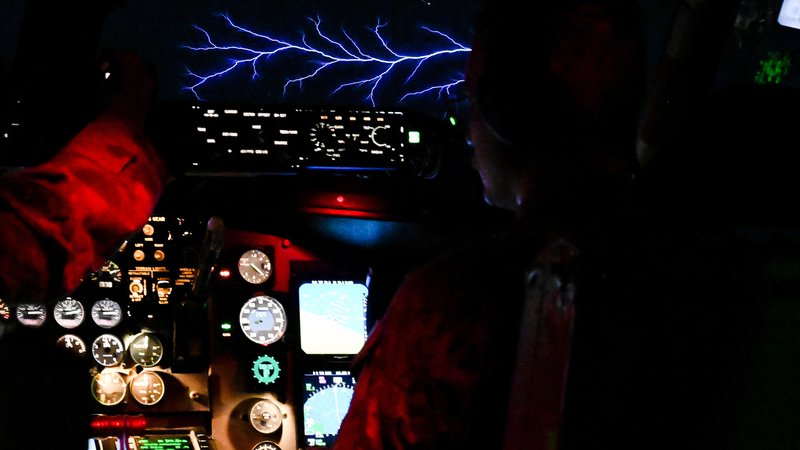
Capt. Katleen Ybarra and 1st Lt. Logan Pethtel, 91st Expeditionary Air Refueling Squadron KC-135 Stratotanker pilots, experience the phenomenon of St. Elmo’s Fire while flying through stormy weather in the U.S. Central Command area of responsibility, Jan. 6, 2023. St. Elmo's Fire occurs through electric friction caused by specific weather conditions. Photo by Tech. Sgt. Diana M. Cossaboom.
The Hurricane Hunters trace their origins to a daring feat performed in 1943 by the legendary American flight instructor and innovator Lt. Col. Joe Duckworth. As the story goes, one day, at Bryan Army Air Field in Texas, a group of seasoned British fighter pilots, including some who had won enough dogfights to be called “aces,” were teasing Duckworth about the flight instruments he had helped develop. So Duckworth offered to prove them wrong by flying an AT-6 “Texan” trainer through the eye of a hurricane as it came ashore in the city of Galveston.
On July 27, 1943, Duckworth and his navigator, Lt. Ralph O’Hair, against the rules set forth by their command, flew into the eye of the storm. The winds and rain were so severe that Duckworth felt, as he recalled later, like he was “being tossed about like a stick in a dog’s mouth.” To the surprise of their doubters, Duckworth and O’Hair returned to base in one piece. From that point on, Bryan Army Air Field would be known as the capital of “instrument flying” and the epicenter of weather reconnaissance flight testing.
In 1944, the U.S. Army created the Army Hurricane Reconnaissance Unit, the original predecessor of today’s Hurricane Hunters. Two decades later, the WC-130 — a Hercules modified for the purpose of weather reconnaissance — joined the unit’s fleet and quickly garnered a reputation as one of the most reliable weather aircraft ever built. The information since collected by the WC-130 has improved the accuracy of hurricane predictions by as much as 30%. The data is provided to the National Hurricane Center in Miami, which broadcasts advanced warnings to the general public.
Related: How Elite Arctic Rangers and Combat Controllers Used To Train for Cold-Weather Rescues
Scientific Research in the Antarctic
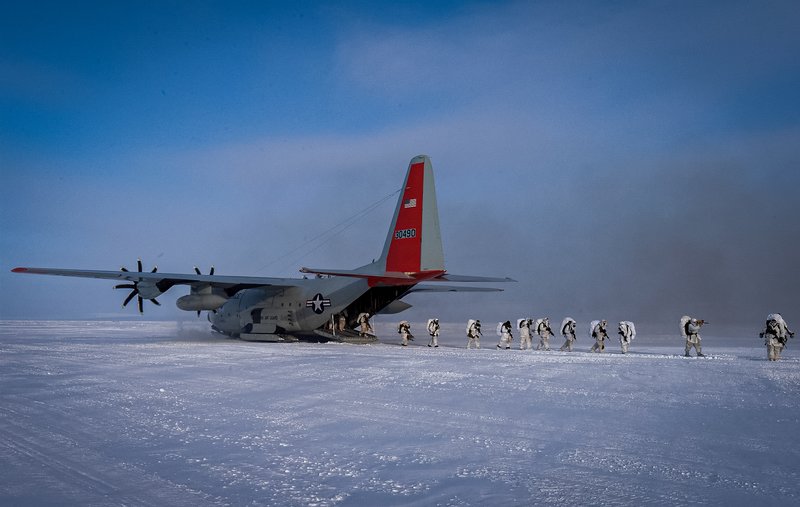
U.S. Army and Canadian Soldiers practiced and conducted tactical insertion on an open ice skiway delivered by an LC-130 Hercules skiplane of the 109th Airlift Wing, New York Air National Guard, on frozen oceanic Arctic ice near Cornwallis Island, Nunavut, Canada, March 15, 2023. Photo by Capt. Mikel Arcovitch.
The LC-130 is another modified version of the Hercules. Nicknamed the “Snowbird,” it was specially designed to support the mission of the National Science Foundation. Its primary role is as a transport aircraft ferrying scientists and supplies between McMurdo Station in Antarctica and the South Pole. A one-way trip is 728 miles. Impressively, the Snowbird, even fully loaded, can complete the journey without having to refuel.
Something else that uniquely qualifies the LC-130 for this particular mission is its ability to get airborne in deep-freeze conditions. How, exactly, does the Snowbird muster enough oomph to take off from a strip of shelf ice? The answer: Engineers affixed rockets to the aircraft’s rear to assist with thrust and counter drag. The modification, called JATO (jet-assisted take-off), is based on technology pioneered by the German aeronautical engineer Ernst Heinrich Heinkel, who developed rocket-powered aircraft for the Luftwaffe during World War II.
The National Science Foundation uses another variant of the Hercules — the NSF/NCAR C-130 — for conducting research expeditions at lower altitudes. The NSF/NCAR C-130’s specialty is flying along the surface of the ocean, sometimes as low as just 100 feet above the water. It is equipped with a variety of sophisticated instruments that do things like measure turbulence, assess icing properties of clouds, and collect oceanic and atmospheric emissions samples.
Related: The CIA Used The Fulton Skyhook to Raid an Abandoned Russian Ice Base
The C-130 Can Also Operate From an Aircraft Carrier … Wait, What?

C-130 Hercules leads a formation of F/A-18C Hornets and A/V-8B Harriers as they fly in formation over the aircraft carrier USS George Washington (CVN 73). The Republic of Korea and the United States are conducting the combined alliance maritime and air readiness exercise "Invincible Spirit" in the seas east of the Korean peninsula from July 25-28, 2010. Photo by Mass Communication Specialist 3rd Class Charles Oki.
In the fall of 1963, the KC-130F — a C-130 modified with long-range aerial-refueling capabilities — became the largest and heaviest aircraft to ever successfully land on an aircraft carrier. The 85,000-pound behemoth came to a complete stop within only 267 feet on the flight deck of the USS Forrestal. Remarkably, it did so without the help of a catapult or an arrestor. According to Military.com, the KC-130F’s incredible stopping power can be attributed to several key modifications, including the incorporation of “a smaller nose-landing gear orifice, an improved anti-skid braking system, and removal of the underwing refueling pods.”
Art Flock, Lockheed Martin’s chief engineer, was aboard the USS Forrestal to witness one of the 21 unarrested full-stop landings it completed in 1963. “That airplane stopped right opposite the captain’s bridge,” Flock said, according to author Joseph Earl Dabney in his book Herk: The Hero of the Skies. “There was cheering and laughing. There, on the side of the fuselage, a big sign had been painted on that said, ‘LOOK MA, NO HOOK.’” Incredibly, the pilots who flew these test runs all had zero prior experience flying a four-engined aircraft.
Through the test flights, it was determined that the C-130 needed only 745 feet to take off and 460 feet to land. Lt. James H. Flatley III, one of the test pilots, received the Distinguished Flying Cross for his participation.
Related: Profile on a Ship: USS Carl Vinson
Blue Angels ‘Fat Albert’ Demonstration Plane
The Navy Flight Exhibition Team was first introduced as the “Blue Angels” at an air show in Omaha, Nebraska, in July 1946. The name has stuck with the team ever since.
For years, the Blue Angels utilized the R4D Sky Train, R5C Commando, R5D Skymaster, and the C-121 Super Constellation as their logistical aircraft. Then, in 1970, a C-130 joined their fleet. Affectionately known as “Fat Albert,” the Blue Angels’ C-130 is operated by a U.S. Marine Corps aircrew. The nickname, an homage to the Fat Albert cartoon that was popular during the 1970s, is, of course, a tongue-in-cheek reference to the aircraft’s enormous size.
In November 1975, Fat Albert’s first JATO demonstration took place at Naval Air Station Pensacola. Each of the eight solid-fuel JATO rocket bottles packed 1,000 pounds of thrust that helped propel Fat Albert into the sky. Because the JATO rocket bottles were last produced during the Vietnam War, the team’s stockpile was completely depleted by the end of 2009 (the same year the video above was taken).
Related: Legendary Fighter Pilot Robin Olds Was an Ace in Two Wars
The AC-130 Gunship in Vietnam
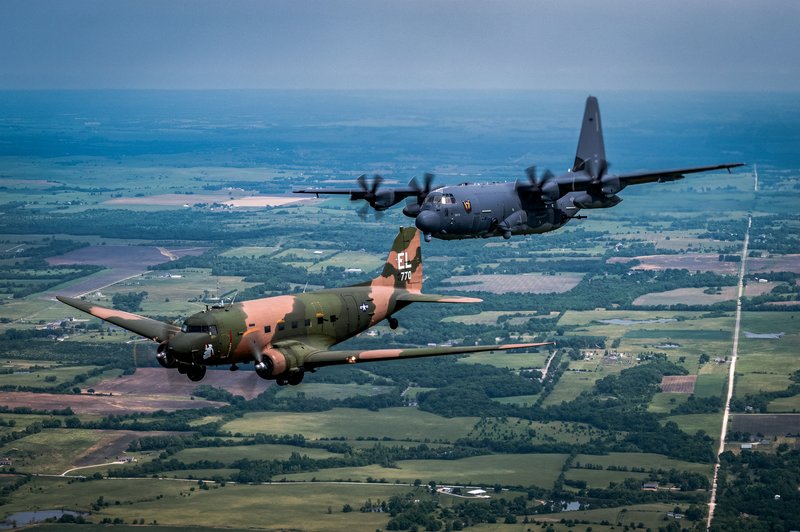
The evolution of the gunship depicting an AC-47 Spooky and an AC-130. Photo by Master Sgt. Christopher Boitz
In the early years of the Vietnam War, outposts occupied by U.S. Army Special Forces teams were frequently attacked by insurgents. The attacks were often carried out at night, and sometimes involved waves of Viet Cong assault troops. Faced with the constant threat of being overrun, the Green Berets made it known that they needed reliable close air support — which, unfortunately, the U.S. Air Force wasn’t capable of providing at the time.
The American fast movers of the early 1960s were designed for air-to-air combat, and the World War II-era bombers were hardly effective at night. So, in 1964, the AC-47 Spooky arrived in Vietnam to fill the capabilities gap. However, while the Spooky could provide effective close air support, it was not adequately equipped to fly above the range of the anti-aircraft batteries that lined the Ho Chi Minh Trail. Further, the first models deployed to Southeast Asia lacked the technology required for night missions.
In time, the necessary improvements were made. In the fall of 1968, the first four AC-130As began “commando hunt” operations in Vietnam, Cambodia, and Laos. Each AC-130A was armed with four 7.62 miniguns and four 20mm cannons. They were also equipped with two visual sensors: a night observation device (typically called a Starlight scope) and FLIR (Forward Looking InfraRed). As gunship operations increased, so did the targeting of enemy truck convoys traveling up and down the Ho Chi Minh Trail. As a result, the North Vietnamese began to rely more on anti-aircraft artillery as a means of defense. To counter the anti-aircraft fire, the Air Force developed a 105mm cannon for the AC-130. First fielded in February 1972, the 105 cannon is, to this day, the largest gun ever fired from an aircraft.
Ret. Air Force Chief Master Sgt. Bill Walter, a former AC-130 gunner and a legend within the U.S. special operations community, has authored two books about the aircraft. In an interview with Coffee or Die, he described the 105 cannon as a game-changing innovation.
“The 105 cannon fires a 32-and-a-half pound projectile at about 1,600 feet per second off the muzzle,” Walter said. “That gun was capable of up to 18,000 feet for an engagement, and it turned out to be a really good system because they could not outfly the gun since a gunship wasn’t capable of going that high.”
Thanks in part to the 105 cannon, the AC-130 gunship neutralized or destroyed approximately 10,000 enemy trucks along the Ho Chi Minh Trail during the war. However, its success came with a heavy price. Approximately 52 AC-130 crew members were killed in action in Laos and Vietnam.
Related: WATCH: The Feared AH-1 Cobra Attack Helicopter Strike Targets Over Vietnam
The Forest Service Debacle

A C-130J Hercules from the 146th Airlift Wing, California Air National Guard, drops fire retardant near Abilene Regional Airport, Abilene, Texas, May 5, 2011. Photo by Staff Sgt. Eric Harris.
Since 1974, the U.S. Forest Service has deployed specially modified C-130s to fly wildfire suppression missions in the Pacific Northwest. These adapted C-130s use the Modular Airborne Fire Fighting System (MAFFS), which gives them the capacity to hold 3,960 gallons of water. Typical fire retardants contain 85% water, and are mixed with fertilizer and chemicals to alter the way fires burn. Also added is a red dye to make its deployment visible from the air. The planes serve as an aerial asset for wildland firefighters on the ground.
In the 1980s, as a result of crafts’ effectiveness, the U.S. Forest Service intended to expand its fleet by outsourcing independent contracts to obtain surplus C-130s. Roy Reagan, a former Air Force pilot, led the effort, representing four companies contracted by the Forest Service to acquire C-130s from the Department of Defense. According to the LA Times, the trade went awry. The Forest Service acquired more than 28 aircraft, including 19 C-130s, while the DoD accepted old planes with little value.
The deal quickly led to a scandal as it became apparent that many of the military aircraft acquired for the Forest Service were not being used for the purpose of fighting wildfires. Instead, some of the C-130s were cannibalized and their parts sold on the black market. In 1991, after the Persian Gulf War, two Forest Service planes were spotted in Kuwait, sparking an investigation by the Agriculture Department’s inspector general that raised questions about whether a number of the C-130s were being used to transport cargo around the globe for private companies and also to carry out covert spying operations. The records for the Forest Service planes mysteriously vanished, and thus so did the complete story of what became of them.
Gary Eitel, a former Vietnam War helicopter pilot and CIA contractor, was the whistleblower who first went public with allegations that the CIA had used the Forest Service’s C-130s for espionage purposes. “You look at them, and you think they are firefighting planes. But they are really little AWACs,” Eitel said in an interview with The Associated Press in 1996. “You could fly into foreign countries and hear what pilots are saying to each other, eavesdrop on embassies; you can jam a national communications system with it.”
Eitel testified on the matter before Congress in the 1990s, after he apparently learned that some of the missing C-130s were about to be sold to drug smugglers in South America.
Related: The Little-Known Stories of Smokejumpers Working With the CIA
Where Were the Gunships in Somalia During ‘Black Hawk Down’?

AC-130 gunships flew fire support missions before and after the Battle of Mogadishu in Somalia in 1993. Wikimedia Commons photo.
In June 1993, three months before the infamous “Black Hawk Down” battle in Mogadishu, Bill Walter and his AC-130 gunship crew were deployed to Somalia to carry out strikes on targets associated with the Somali warlord Mohamed Farrah Aidid.
“We went over there and shot up the cigarette factory, which was his main bivouac area,” Walter, the retired Air Force chief master sergeant, told Coffee or Die. “[We] shot up Radio Mogadishu, shot up his tank yard, and things of this nature.”
Within two weeks of returning to the States, Walter’s team was preparing for gunship missions in Bosnia when the U.S. military decided to capture Aidid. The Army’s special missions unit was tapped to lead the task force, which would also include troops from the 75th Ranger Regiment, the 10th Mountain Division, and the 16th Special Operations Squadron.
That, at least, was the original plan. Before the task force left for Somalia, Gen. Joseph Hoar, the head of U.S. Central Command at the time, decided that AC-130s weren’t necessary for the mission. “The trouble was Gen. Hoar didn’t want to send the gunships because we were trying to de-escalate the situation instead of escalate it,” Walter recalled. “In my opinion, that was a big mistake because the Somalis didn’t like what we did to them in June and July, so they had a natural fear of the gunship already.”
The task force went to Somalia without the gunships. On Oct. 3, 1993, Army commandos raided a three-story building in Mogadishu and captured several of Aidid’s lieutenants. En route back to base, a Black Hawk helicopter was shot out of the sky. The 17-hour battle to secure the crash site and rescue the survivors resulted in 18 Americans killed in action and 73 more wounded.
Soon after the “Black Hawk Down” incident, Walter’s squadron returned to Somalia. They flew day and night conducting armed surveillance and also carried out several strikes on insurgent targets in and around Mogadishu.
“That pretty much announced to everybody there that these gunships are back again and they’re pounding us,” Walter said. “The very next day, Aidid called for a ceasefire.”
Related: 5 Things You Probably Didn’t Know: ‘Black Hawk Down’
The Kabul Airlift
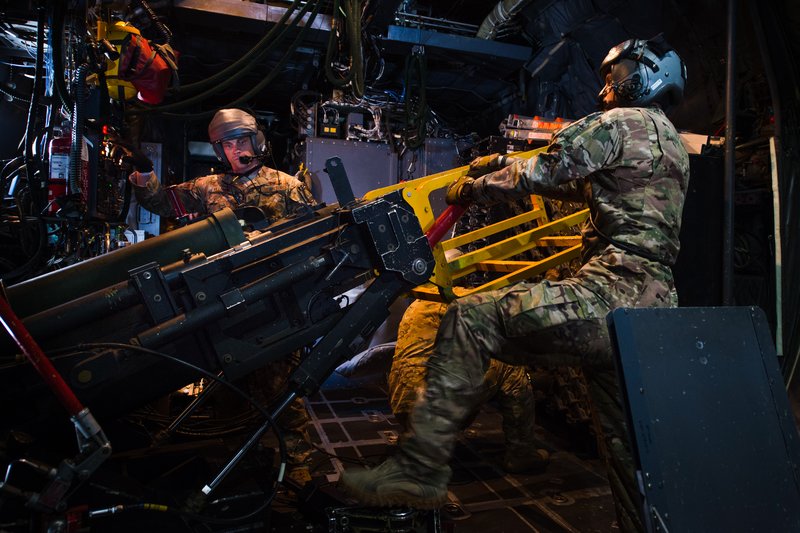
Aircrew with the 4th Special Operations Squadron conduct a routine training mission in an AC-130U Spooky gunship at Hurlburt Field, Fla., June 19, 2018. The AC-130U gunship’s primary missions are close air support, air interdiction and armed reconnaissance. Photo by Senior Airman Joseph Pick.
In August 2021, two AC-130J gunship flight crews were given the Air Force’s annual Mackay Trophy for performing the “most meritorious flight” of the Kabul airlift. As Taliban fighters poured into Kabul, Afghanistan, on Aug. 15, 2021, the crews of the two AC-130Js — Ghostriders, as the crews call them — watched over the evacuation of the U.S. Embassy and more than 2,000 Americans. One of the gunships, Shadow 77, flew 15.7 hours, the longest flight ever for a standard Ghostrider crew.
Shadow 77 pilot Capt. Lawrence “Lars” Bria recounted the mission in an interview with Coffee or Die.
“That night was just a testament to American aviation in general,” Bria said. “There were all sorts of American aviation there that night, and I’m proud to have been part of it. As much as I love it as a win for us in the Shadow world, I definitely think the trophy was a win for everybody that night.”
Bria told Coffee or Die how — flying at more than 10,000 feet over the collapsing city — the crews of Shadow 77 and Shadow 78 provided overwatch for the U.S. ambassador’s journey to the Kabul airport, beamed live video back to officials in Washington, D.C., and dispersed mobs with green-light lasers, a nonlethal trick used by gunships to pacify hostile civilians.
The two crews flew a combined 30 hours overseeing the evacuation before returning to their base in the United Arab Emirates.
Vice Chief of Staff of the Air Force Gen. David Allvin presented the Mackay Trophy to the Ghostrider crews in a Dec. 7, 2022, ceremony at the National Museum of the U.S. Air Force at Wright-Patterson Air Force Base, Ohio.
Read Next: The Gunships That Didn’t Shoot: 30 Hours Inside Two AC-130Js Over Kabul

Matt Fratus is a history staff writer for Coffee or Die. He prides himself on uncovering the most fascinating tales of history by sharing them through any means of engaging storytelling. He writes for his micro-blog @LateNightHistory on Instagram, where he shares the story behind the image. He is also the host of the Late Night History podcast. When not writing about history, Matt enjoys volunteering for One More Wave and rooting for Boston sports teams.
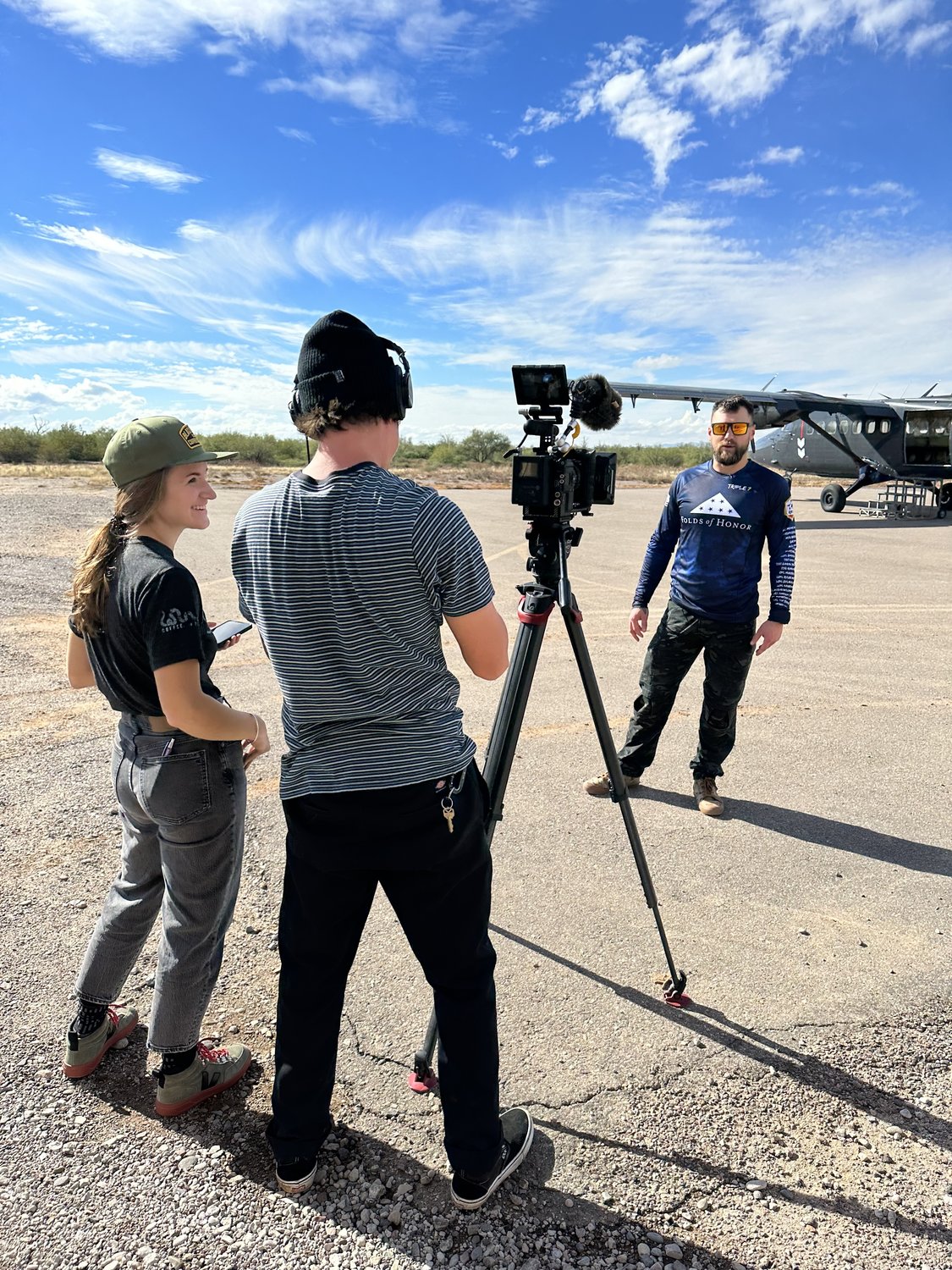
Jenna Biter is a staff writer at Coffee or Die Magazine. She has a master’s degree in national security and is a Russian language student. When she’s not writing, Jenna can be found reading classics, running, or learning new things, like the constellations in the night sky. Her husband is on active duty in the US military. Know a good story about national security or the military? Email Jenna.
BRCC and Bad Moon Print Press team up for an exclusive, limited-edition T-shirt design!
BRCC partners with Team Room Design for an exclusive T-shirt release!
Thirty Seconds Out has partnered with BRCC for an exclusive shirt design invoking the God of Winter.
Lucas O'Hara of Grizzly Forge has teamed up with BRCC for a badass, exclusive Shirt Club T-shirt design featuring his most popular knife and tiomahawk.
Coffee or Die sits down with one of the graphic designers behind Black Rifle Coffee's signature look and vibe.
Biden will award the Medal of Honor to a Vietnam War Army helicopter pilot who risked his life to save a reconnaissance team from almost certain death.
Ever wonder how much Jack Mandaville would f*ck sh*t up if he went back in time? The American Revolution didn't even see him coming.
A nearly 200-year-old West Point time capsule that at first appeared to yield little more than dust contains hidden treasure, the US Military Academy said.












